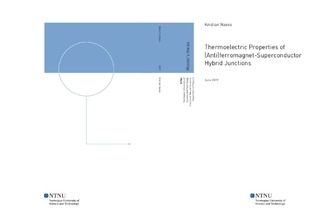| dc.description.abstract | Denne masteroppgaven undersøker de termiske egenskapene til både en ferromagnet-superleder overgang og en antiferromagnet-superleder overgang. Målet med oppgaven er å utlede, grafisk fremstille og evaluere termisk ledningsevne, Seebeck-koeffisienten og godhetstallet til disse to overgangene, for å vurdere deres kvalitet som termoelektrisk innretning. I ferromagnettilfellet ser vi på hvordan termisk ledningsevne, Seebeck-koeffisienten og godhetstallet blir berørt av en samtidig inkludering av både Rashba- og Dresselhaus spinnbane-vekselvirkning. I antiferromagnettilfellet er det et gap i forskningslitteraturen relatert til oppførselen til Andreev refleksjon, og vi ønsker derfor å undersøke dette nærmere, sammen med en utregning av termisk ledningsevne, Seebeck-koeffisienten og godhetstallet for denne materialforbindelsen.
Blonder-Tinkham-Klapwijk formalismen er utnyttet for å finne bølgefunksjonene for både (anti)ferromagneten og superlederen. Videre er grensebetingelser og NSolve funksjonen til den matematiske programvaren Mathematica utnyttet for å finne sannsynligheten for fire forskjellige spredningsprosesser; Andreev refleksjon, normal refleksjon, tunneling som elektronlik partikkel og tunneling som hullik partikkel. Disse sannsynlighetene spiller senere en viktig rolle i uttrykkene for termisk ledningsevne, Seebeck-koeffisienten og godhetstallet.
Oppgaven viser at sannsynligheten for Andreev refleksjon er lavere desto høyere polarisasjonen er, og dermed vil en høy polarisasjon senke den termiske ledningsevnen. Videre vil termisk ledningsevne øke med økende temperatur, mens det superledende gapet, og dermed sannsynligheten for Andreev refleksjon, vil minske. Resultatene viser også at en større skalar barriere vil øke sannsynligheten for normal refleksjon. Et godt termoelektrisk materiale har et høyt godhetstall, og for ferromagnet-superleder overgangen fikk vi et godhetstall på 5 ved bruk av en skalar barriere Z = 4, polarisasjon P = 0.9 og normalisert temperatur T_d = 0.4. Dette tallet er betydelig høyere enn hva man kan finne i dagens termoelektriske innretninger. For antiferromagnet-superleder overgangen fant vi Hamiltonian i matriseform, samt egenvektorer og bølgefunksjonene som beskriver partikkeloppførselen i både antiferromagneten og superlederen. Selv om videre forskning er nødvendig for å finne de endelige resultatene for termisk ledningsevne, Seebeck-koeffisienten og godhetstallet vil forhåpentligvis utfallet av dette forskningsprosjektet være av stor verdi ved videre analyse av antiferromagnet-superleder overganger. | |
| dc.description.abstract | This master's thesis investigates the thermoelectrical properties of the (anti)ferromagnet-superconductor hybrid junction. The purpose of the thesis is to derive, plot and evaluate the thermal conductivity, Seebeck coefficient and figure of merit of the two hybrid junctions, in order to assess their value in thermoelectric devices. In the ferromagnet, the simultaneous inclusion of both Rashba spin-orbit interactions and Dresselhaus spin-orbit interactions is of special interest as no one have investigated its effect on thermal conductivity, Seebeck coefficient and figure of merit before. For the antiferromagnet-superconductor junction, the behavior of Andreev reflection is still unknown, and insight into Andreev reflection behavior, as well as thermal conductivity, Seebeck coefficient and figure of merit of the junction serve as the main objective of the study.
The BTK formalism has been utilized in the research to find the wave functions for both the (anti)ferromagnet and superconductor regions. Using boundary conditions and the NSolve function in Mathematica, the probabilities for four different scattering processes were found; Andreev reflection, normal reflection, tunneling as electron-like particles, and tunneling as hole-like particles. These probabilities are then used in the expressions for thermal conductivity, Seebeck coefficient and figure of merit.
The study shows that Andreev reflection is reduced with the inclusion of polarization in the ferromagnet-superconductor junction, thereby reducing thermal conductivity. Further, thermal conductivity increases with temperature, while the superconducting gap, and hence Andreev reflection probability, is reduced. It is also shown that a higher scalar barrier gives higher normal reflection probability. A good thermoelectric material is known for a high figure of merit, and for no spin-orbit coupling, a scalar barrier Z = 4, polarization P = 0.9, and normalized temperature T_d = 0.4, the results show that the figure of merit of the ferromagnet-superconductor junction is approximately 5, a number that is a lot greater than what conventional thermoelectric devices have today. By including Rashba spin-orbit interactions and Dresselhaus spin-orbit interactions, the results show that it is possible to achieve a figure of merit of 80, indicating that an intelligently designed ferromagnet-superconductor junction can be a very good thermoelectric material.
For the antiferromagnet-superconductor junction the matrix Hamiltonian is found, together with the eigenvectors and wave function describing the particle behavior in the material. Although further research is needed to find the thermal conductivity, Seebeck coefficient and figure of merit for the antiferromagnet-superconductor junction, the present findings will hopefully be of high value for further supplementary analysis of the antiferromagnet-superconductor junction. | |
